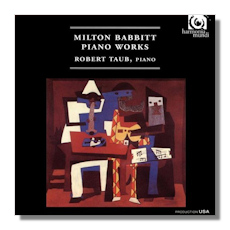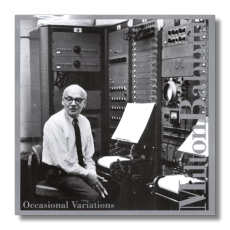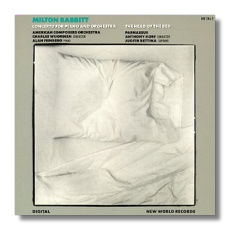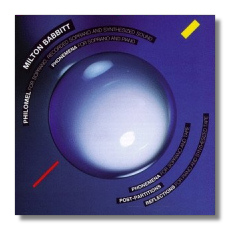
The Internet's Premier Classical Music Source
Related Links
-
Find CDs & Downloads
Amazon - UK - Germany - Canada - France - Japan
ArkivMusic - CD Universe
Find DVDs & Blu-ray
Amazon - UK - Germany - Canada - France - Japan
ArkivMusic-Video Universe
Find Scores & Sheet Music
Sheet Music Plus -
Recommended Links
Site News
Milton Byron Babbitt
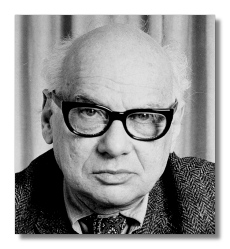
(1916 - 2011)
Everything in Milton Babbitt's (May 10, 1916 - January 29, 2011) music serves a constructive function. The first works in which linear succession, harmonic simultaneity, duration (including rhythm and tempo), dynamics, articulation, register, and timbre are all strictly derived from a single, all-inclusive premise were written by Babbitt in 1948. Three Compositions for piano, Compositions for Four Instruments, Composition for Twelve Instruments – show the row as a "set" of values and relationships, absolutely and strictly defined not only in terms of structure but also of operational process, he applies the serial technique in a strict dodecaphonic procedure: maintaining the fixed order of the twelve tones in the vertical (harmony) and the linear (melodic) succession. He characteristically bases his pitch organisation on bringing together fractions of serial forms to produce 'aggregates' of all 12 pitches: Du a song cycle establishing a genuine serial polyphony, Composition for Viola and Piano, Composition for Tenor and Six Instruments.
He was one of the foremost contributors to the Columbia-Princeton Electronic Music Center – the principal Center for tape and electronic music in the United States. Vision and Prayer and Philomel shows his use of the human voice as an essential part of the electronic conception and are examples of combined live performance with tape. In Sounds and Words and Phonemena, both for soprano and piano or tape, the set of nonsense phonemes are associated with pitches according to rules of 12-tone organisation – the music gives rise to the text instead of being derived from one, Composition for Synthesizer, Ensembles for Synthesizer show his concern with new ways of organising time and form perception.
All Set for jazz ensemble and Partitions for piano (are works in which he uses the notion of 'time points' – his search for achieving a polyphony in which the rhythmic organisation combines, though not duplicates, the pitch organisation – as used in most of his works from 1957 onwards and realised through the electronic studio where the rhythmic precision demanded by his system could be realised), Sounds and Words for soprano and piano, combine his clarity and care with a new richness and lively virtuosity appropriate to the conditions of live performance; Two Sonnets for baritone, clarinet, viola and cello exhibit a neat parallel between the rhyme scheme and serial forms employed, the Second Quartet is a model of lucid serial organisation.
His later works: Post-Partitions for piano, and Relata I for orchestra, show his concentration of musical meaning, through the close connection between the pitch organisation and the rhythmic organisation, and his use of every parameter to assist in conveying structure. The Third Quartet shows features of metronomic stability, of changes of velocity engineered by changes in metrical density, of sectional formation, and of the use of every musical parameter – including the distinction between arco and pizzicato, to project the structure of the integrated polyphony. He has had a strong influence as a teacher and theoretician in the United States. Chance elements are not found in his music. His interest is the mental limitations on the nature and complexity of musical structures which the composer may propose. He believes that the serious composer today should accept his isolation from the public as a necessary condition of his functioning, and should proceed to develop the resources of his art in works neither suitable nor intended for the average listener.
Recommended Recordings
Piano Music
- Piano Music (Complete)/Harmonia Mundi HMC905160
-
Richard Taub (piano)
String Quartets
- String Quartets #2 (1954) & 6 (1993) with Occasional Variations & Composition for Guitar/Tzadik 7088
-
Composers String Quartet
- String Quartet #3 (1970) with Wuorninen/Music & Arts CD707
-
Fine Arts String Quartet
- String Quartet #4 (1970) with Sessions & Wolpe/CRI CD587
-
Juilliard String Quartet
- String Quartet #5 with Carter & Powell/Music & Arts CD606
-
Composers String Quartet
 Piano Concerto
Piano Concerto
- Piano Concerto (1985), The Head of the Bed/New World 80346
-
A. Feinberg (piano), Charles Wuorinen/American Composers Orchestra
Experimental / Electronic Works
- Philomel, Phonemena, Post-partitions, Reflections/New World 80466
-
Bethany Beardslee (soprano), Lynne Webber (soprano), Jerry Kuderna (piano), Robert Miller (piano)














